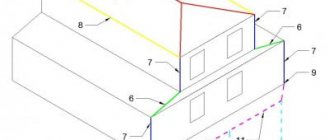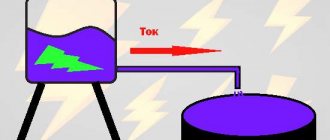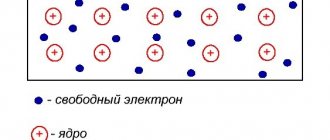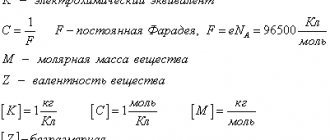When electricity appeared in our lives, few people knew about its properties and parameters, and various materials were used as conductors, it was noticeable that with the same voltage value of the current source, there was a different voltage value at the consumer. It was clear that this is influenced by the type of material used as a conductor. When scientists began to study this problem, they came to the conclusion that the charge carriers in the material are electrons. And the ability to conduct electric current is determined by the presence of free electrons in the material. It was found that some materials have a large number of these electrons, while others do not have them at all. Thus, there are materials that conduct electricity well, and some that do not. Based on the above, all materials were divided into three groups:
Each of the groups has found wide application in electrical engineering.
Conductors
Conductors are materials that conduct electric current well; they are used for the manufacture of wires, cable products, contact groups, windings, tires, conductive cores and tracks. The vast majority of electrical devices and apparatus are made on the basis of conductive materials. Moreover, I will say that the entire electric power industry could not exist without these substances. The group of conductors includes all metals, some liquids and gases.
It is also worth mentioning that among the conductors there are super conductors, the resistance of which is almost zero; such materials are very rare and expensive. And conductors with high resistance - tungsten, molybdenum, nichrome, etc. Such materials are used to make resistors, heating elements and spirals of lighting lamps.
But the lion's share in the electrical field belongs to ordinary conductors: copper, silver, aluminum, steel, and various alloys of these metals. These materials have found the widest and most extensive use in electrical engineering, especially copper and aluminum, since they are relatively cheap and their use as conductors of electric current is most appropriate. Even copper is limited in its use; it is used as winding wires, multi-core cables, and more critical devices; copper busbars are even less common. But aluminum is considered the king among electrical conductors, although it has a higher resistivity than copper, but this is compensated by its very low cost and resistance to corrosion. It is widely used in power supply, cable products, overhead lines, busbars, general wires, etc.
Semiconductors
Semiconductors are something between conductors and semiconductors. Their main feature is their dependence to conduct electric current on external conditions. The key condition is the presence of various impurities in the material, which provide the ability to conduct electric current. Also with a certain arrangement of two semiconductor materials. Based on these materials, at the moment, many semiconductor devices have been produced: diodes, LEDs, transistors, semistors, thyristors, stabistors, various microcircuits. There is an entire science dedicated to semiconductors and devices based on them: electronic engineering. All computers, mobile devices. What can I say, almost all of our equipment contains semiconductor elements.
Semiconductor materials include: silicon, germanium, graphite, graphene, indium, etc.
Dielectrics
Well, the last group of materials are dielectrics , substances that are not capable of conducting electric current. Such materials include: wood, paper, air, oil, ceramics, glass, plastics, polyethylene, polyvinyl chloride, rubber, etc. Dielectrics are widely used due to their properties. They are used as an insulating material. They protect the contact of two live parts and prevent direct human contact with these parts. The role of dielectrics in electrical engineering is no less important than the role of conductors, as they ensure stable, safe operation of all electrical and electronic devices. All dielectrics have a limit up to which they are unable to conduct electric current, this is called the breakdown voltage. This is an indicator at which the dielectric begins to pass electric current, while heat is released and the dielectric itself is destroyed. This breakdown voltage value is different for each dielectric material and is given in reference materials. The higher it is, the better, the more reliable the dielectric is considered.
The parameter characterizing the ability to conduct electric current is resistivity R , unit of measurement [ Ohm ] and conductivity, the reciprocal of resistance. The higher this parameter, the worse the material conducts electric current. For conductors it ranges from several tenths to hundreds of Ohms. In dielectrics, the resistance reaches tens of millions of ohms.
All three types of materials are widely used in the power industry and electrical engineering. And they are also closely interconnected with each other.
A metal has been found that allows electric current to pass without producing heat.
Semiconductors
This is a special group of substances that conducts electric current when certain conditions are created. In the crystal lattice of semiconductors, there is an extremely limited presence of free charge carriers. But when appropriate conditions are created, for example, when exposed to light, a decrease or increase in temperature, or any specific factors, the number of released carriers increases.
Substances that conduct electric current and belong to the group of semiconductors have one feature - under the influence of external factors, bound electrons leave their place and form the so-called. "hole". It has a positive charge. When an electric field is created, electrons and “holes” move towards each other, forming an electric current. This feature is called electron-hole conductivity. The most common semiconductors are silicon, germanium, selenium, gallium, tellurium, etc.
Water doesn't conduct electricity
Everyone knows that water and electricity are a very dangerous combination. However, water itself does not conduct current. Then why is water considered a good conductor?
To understand this, you need to imagine an atom, which consists of protons, neutrons and electrons. The ratio of neutrons and electrons determines the charge of an atom.
If the number of protons is greater than electrons, the charge is positive; if vice versa, the charge is negative. As atoms strive toward a neutral charge, they give up or take away electrons.
When an electron passes from a negatively charged atom to an atom with a positive charge, an electric current is generated.
Since water molecules have no charge, they do not conduct electricity. Therefore, distilled water is considered a dielectric, that is, it does not conduct current. However, such water is rare.
All the water that flows from the tap, contained in rivers, lakes and seas, is a mineral solution of one concentration or another.
It contains both positively (calcium, magnesium, sodium, iron) and negatively (chlorine, sulfate, carbonate) charged particles, so this water conducts current well, and the higher the concentration of mineral salts, the better.
10 mysteries of the world that science has finally revealed
"Moving stones", strange legs of giraffes, singing sand dunes and other amazing mysteries of nature that we have been able to solve over the past few years. 1.
The Secret of the "Moving Rocks" in Death Valley From 1940 until recently, Racetrack Playa, a dry, flat-bottomed lake located in Death Valley in California, was the site of the "moving rocks" phenomenon.
Many people puzzled over this mystery. For years or even decades, some force seemed to move... Read more...
Atom, luster, nuctemeron, and seven more units of time that you haven't heard of
When people say they are “enough with the moment,” they probably don’t realize that they are promising to be free in exactly 90 seconds.
Electric current in liquid and photoelectric effect • Library
The most interesting, attractive and useful thing about the photoelectric effect is the possibility of obtaining electromotive force, i.e. work on moving electric charges, which is performed by forces of non-electric origin.
Indeed, when light interacts with matter, electrons are redistributed across energy levels. If the quantum energy exceeds the band gap, the electron moves from the valence band to the conduction band.
As a result, the electrode that has lost an electron acquires a positive charge, which, in fact, is the reason for the occurrence of electric current in the circuit.
However, not all so simple. Conventional materials - metals and dielectrics - have a fairly large band gap, which, in essence, turns out to be an obstacle to obtaining a cheap and environmentally friendly source of energy.
Therefore, any attempts to create a material characterized by a maximum ratio of the photocurrent strength to the amount of light flux incident on the surface of the working substance should be welcomed. For example, a single crystal of germanium produces remarkable results, but a solar battery created in this way turns out to be economically unprofitable.
And this is not the only obstacle to energy progress. Fragility is what can and does spoil the cloudless life of consumers of cloudless energy.
However, the solution to this photovoltaic problem seems to be on the surface. It so happened that the photoelectric effect discovered with the help of liquid now casts its fate to a greater extent with semiconductors.
It is also true that the contact of a semiconductor or metal with a liquid (electrolyte) has made it possible to learn a great deal about the nature of the interaction of optical radiation with matter, but the possibility of using the contact of an ordinary metal with an ordinary liquid for practical purposes has remained untouched.
Therefore, we will try to make our contribution to the study of this remarkable phenomenon, especially since such a relatively simple study is possible in an ordinary educational laboratory.
Lamp, aluminum can and a pair of cutlery
Almost everything that is needed to make an experimental setup is presented in Figure 1. The liquid under study is located in a cylindrical cuvette, the side surface of which ( K
) with a diameter of 75 mm and a height of 45 mm, made of aluminum. This is one electrode of a photovoltaic device.
The second cylindrical electrode ( to
) with a diameter of 10 mm and a height of 45 mm.
Since the effect of light from a lamp ( L
) on a liquid is being studied, it is necessary to avoid light falling on the surface of metal electrodes.
Two screens are used for this ( E
) and (
uh
), made of light-proof plastic. The heights of the screens are the same and are 40 mm, the internal diameter of the large screen is 40 mm, the external diameter of the small screen is 20 mm.
The choice of aluminum as electrodes is due to the fact that the thickness of the aluminum-water transition layer has an extremely high electrical capacity, and there is hope that the exposure process can be extended over time.
As a working fluid, which is expected to play the most active part in the formation of the photoelectric effect, it is best to use distilled water. Why? There is a lot of water in nature - this is one thing. There is hope to avoid interference caused by chemical processes - that's two.
Between the light source ( L
) and the cuvette with the test liquid contains an absorber (
P
) - to get rid of the heating of the liquid by the lamp. The light source can be almost any energy-saving lamp, for example an E27-9W/C:4000 K lamp.
The choice of absorber is quite obvious - it is a layer of water one and a half centimeters high, poured into a thin-walled cuvette. It is hoped that the infrared radiation from the lamp will be completely suppressed by such an absorber.
In the future, the absorber can be replaced with a light filter if spectrometric measurements are required.
A photoresistor ( FS)
), which makes it possible to unambiguously judge the illumination of the surface of the liquid under study.
Two more devices are needed. One of them measures the voltage drop across the load resistance ( R
= 15 kOhm), and the second measures the resistance of the photoresistor.
So far only experience (observation)
Having filled the cuvette with distilled water and connected the millivoltmeter, you begin to suspect that the direction of the current in Figure 1 is indicated incorrectly. Both so and not so. In fact, even distilled water, no matter how pure it is, still chemically interacts with the metal. This is exactly what happens immediately after you pour water into the cuvette.
Having turned on the light source, you discover a rather strange circumstance: the current in the circuit not only changes in magnitude, but also changes direction (Fig. 2). After turning off the lamp, the current slowly, very slowly, returns to the “negative” region, but does not restore its value.
We'll have to wait ten hours before we can start measuring again.
Experiment one. Absorber selection
A day after loading water into the cuvette, the dark current (current in the circuit when the light source is turned off) becomes almost constant. Why this happens is still unclear.
No matter how low-power the lamp that plays the role of a light source is, heating the liquid in the cuvette is still possible. This means that you need a thermometer that allows you to control this process. The design of the cuvette allows you to install a small thermometer, or better yet, a thermocouple, without any problems.
Photocurrent can be treated in two ways. First of all, this is the process of changing the current in the circuit due to optical irradiation. The quantitative characteristic of this process can also be called photocurrent: we can agree that this is the current in the circuit at a certain point in time minus the current in the circuit at the moment the light source is turned on.
Dielectrics
There are no free charge carriers in dielectrics. The flow of electric current in such substances is impossible under standard external conditions. The most popular materials that do not conduct electricity are mica, ceramics, rubber and rubbers.
They can also include air and certain types of gases, but for them, the degree of pollution will be decisive. If there are a sufficient number of free ions, they lose their dielectric properties. Thus, one cannot blindly assume that any substance is an absolute dielectric and does not conduct electricity. Under certain circumstances, most substances known to be dielectrics can acquire the properties of semiconductors.
For example, iron oxide, which under normal conditions prevents the flow of electric current, becomes conductive when the pressure and temperature increase, while its internal structure is not disturbed.
To summarize, we note that the qualitative difference between substances that transmit or prevent the flow of electric current is their conducting state. For metals it is constant, and for dielectrics and semiconductors it is an excited phase. Conductivity is quantified in terms of electrical resistivity.











